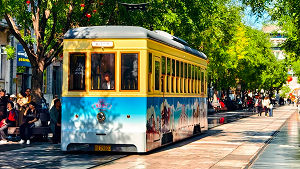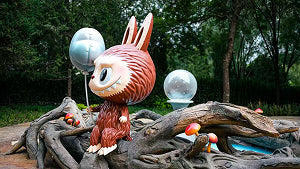Just south of Tiananmen Square, stretching toward the old city wall, lies Qianmen Street (前门大街)—a place where imperial history and modern life walk the same cobbled path. And tucked just behind it is Dashilan (大栅栏), Beijing’s oldest commercial hub, where time-honored brands and family stories still echo through narrow alleys.
Together, Qianmen Street and Dashilan are not just sightseeing stops—they’re windows into Beijing’s evolving identity, where past and present live side by side.
1. What to See and Do on Qianmen Street

- Zhengyangmen (正阳门): Start at the imposing gate tower, once the southern gate of the Inner City.
- Qianmen Tram: Ride the old-style trolley that rolls down the street—charming, photogenic, and nostalgic.
-
Time-Honored Brands:
- Quanjude (全聚德): Beijing’s most famous Peking duck since 1864.
- Tongrentang (同仁堂): Traditional Chinese medicine dating to the Qing dynasty.
- Zhang Yiyuan (张一元): Classic tea house where locals still sip jasmine tea.

Bridge To Locals Tip: Don’t miss the mix of modern twists—pop-up galleries, boutique cafés in courtyards, and opera-mask souvenir stalls.
2. Qianmen: From Imperial Gateway to Commercial Boulevard
The name Qianmen means “Front Gate,” referring to the grand Zhengyangmen tower that guarded the southern approach to the Forbidden City. For centuries, imperial envoys, soldiers, and merchants passed through this gate carrying tribute, silk, and grain.
By the Qing Dynasty, the area south of the gate had transformed into Beijing’s busiest commercial street. Tea houses, opera stages, silk shops, and pharmacies created a vibrant cultural hub. In the early 20th century, Qianmen also became a symbol of modernization, where trams and foreign brands mixed with age-old Chinese businesses.

Today, strolling down Qianmen feels like walking through a living museum of Beijing’s identity — one that has always balanced tradition and innovation.
Bridge to Locals' Tips: As a popular travel area, Dashilan and Qianmen are full of small shops selling everything from opera masks to silk scarves. Some of these can be heavily marked up for tourists. Don’t be afraid to try bargaining politely, or better yet, let a local friend handle it for you—they’ll know what’s fair and may even help you spot which stores are worth your time.
3. Dashilan: Beijing’s Oldest Market Street
The name Dashilan means “big wooden fence,” a reference to gates once built to control fire risks in this bustling trading hub. Since the Ming Dynasty, Dashilan has been where merchants unloaded goods, stored them in sheds, and built businesses that would last for centuries.

By the Qing era, Dashilan had become the commercial heartbeat of Beijing, with legendary brands still thriving today:
- Tongrentang (同仁堂): Traditional Chinese medicine.
- Ruifuxiang (瑞蚨祥): Fine silks and fabrics.
- Majuyuan (马聚元): Handmade hats.
- Neiliansheng (内联升): Iconic cloth shoes.
- Liubiju (六必居): Famous for pickles and condiments.
Walking Dashilan today is a chance to browse shops where emperors once shopped in secret and to witness how traditions adapt for modern tastes.

Why Travel Qianmen with Bridge to Locals?
In an age where information is everywhere—where ChatGPT and the internet can already tell you dates, names, and historical facts—we believe travel should be more than listening to endless explanations.
At Bridge to Locals, our mission is to weave history and culture into lived experience. Walking Qianmen with us isn’t about memorizing facts; it’s about stepping into the atmosphere and sharing it with real people.

With our local companions, you might:
-
Dress in Republic of China–era clothing, recreating the feeling of old Beijing and turning Qianmen into your own time-travel backdrop.
-
Sit in a traditional tea house, sipping jasmine tea while your host shares their family’s connection to the area—stories that don’t appear in guidebooks.
-
Hear personal anecdotes about how Qianmen has changed—from grandparents who once shopped for shoes at Neiliansheng, to parents who still remember lining up for roast duck at Quanjude.
It’s not about adding more facts to your notebook—it’s about creating moments of connection, where history isn’t just told, but lived together.
A Word of Honesty: Beyond the Polished Facade
Qianmen and Dashilan are beautiful, but some travelers find them over-commercialized. Crowds, souvenir shops, and standardized storefronts can make them feel staged. That’s why a local guide matters. With Bridge to Locals, you can slip beyond the façade into real hutong life — alleys where neighbors play mahjong, families cook in courtyards, and the pulse of Beijing remains unchanged.

We’ll keep sharing more about those hidden hutongs—places only locals still know.Let Bridge to Locals turn your visit into a memory — one where Beijing’s past and present meet in your own story.
Subscribe to stay tuned for the next chapter.







Leave a comment
This site is protected by hCaptcha and the hCaptcha Privacy Policy and Terms of Service apply.